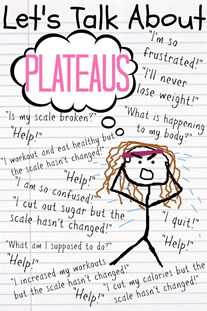Breaking Through Weight Loss Plateaus
Has this ever happened to you? When you face down failed attempts to diet and watch your weight loss, only to find out that your body starts shutting down after a few weeks of success? This stalement occurs far too often, whether the person is using a proven method like real HCG or another popular weight loss technique that’s also proven effective. Your scale stops moving daily and you just can’t seem to make any progress anymore. This is the point that nearly all dieters fail, but there are many ways a person can also overcome these problems and kickstart their progress once again.
These plateaus are common and have been identified in hundreds of studies as being a significant detriment to weight loss. Your body is designed to adapt to changes in the foods you eat, which means that it will make changes to your metabolism to continue your present weight and prevent weight loss. In order to keep your body from hitting these plateaus, you need to keep your body guessing, changing up your diet, your exercise regimen and you food intake regularly so that your body will burn more stored fat to meet these demands.
 Root Out Problems in Your Diet
Root Out Problems in Your Diet
It’s not advisable to restrict your diet to a handful of calories per day, at least without outside help from other methods like HCG or metabolic boosters. The key is really just to avoid processed foods, and make your diet about raw and natural foods primarily. Though there is always some general advice on the number of carbs to eat per day (50-55% of your calories for example) many people experience breaks in plateaus when they switch from carb heavy to protein heavy and visa versa. Other people may be more sensitive to other things, such as fat intake, or caloric content in general, so changing this up as well may be sufficient to break plateaus.
Increasing How Often You Have Meals
One of the easiest ways to boost your metabolism if you’re struggling during your diet is to split up your food intake into a few meals per day. Rather than just 3 (or 2 meals as is often the case) you should increase this to 5 smaller meals to keep your metabolism working all day long. This helps tremendously, as your body will process and consume that food and assume more is coming shortly. This helps boost your metabolism substantially. This is also one of the most effective ways to control cravings, which are often a major problem for dieters.
Change Up Your Calorie Intake
If you cut calories massively, sure you will lose weight quickly. There’s no doubt about that, but eventually your body will adapt and begin to conserve its stored fat as well. Prolonging this period is possible with help from things like the HCG hormone, but it’s not often able to be achieved through normal calorie deficit means. Your body will enter starvation mode quickly, and you will burn far fewer calories. This loss of metabolic rate is hard to control, and merely exercising will not guarantee that it will remain high. As a result, it’s advised that dieters switch up their caloric intake and avoid staying on the same calories per day over long periods of time. You want to switch between a normal diet, and a low calorie diet, so that your body loses the fat on the low calorie days and increases your metabolism on the more normalized days. Unless you’re doing something that helps maintain metabolism, like the HCG hormone, this is the best solution.
Increase your Duration and Frequency
Many people use exercise to help them along in their weight loss. This is certainly a great addition to any weight loss methodology, even those that typically say they don’t require it. A good number for cardiovascular exercise is try to get at least 30 minutes in per session, or at least 3 hours per week total. This may not be achievable with your schedule, in which case doing more rigorous muscle building exercises like weight training helps to burn fat as well. Muscle helps to burn fact quickly.
If you are regularly lasting upwards of 60 minutes on your workouts, the next thing if you’re not receiving results is to check out the frequency of the exercises. You should be aiming for several times per week for exercise, though you can go as much as seven or so times per week! This can really turn your results around and help you to increase your metabolism.
Categories: Successful Dieting